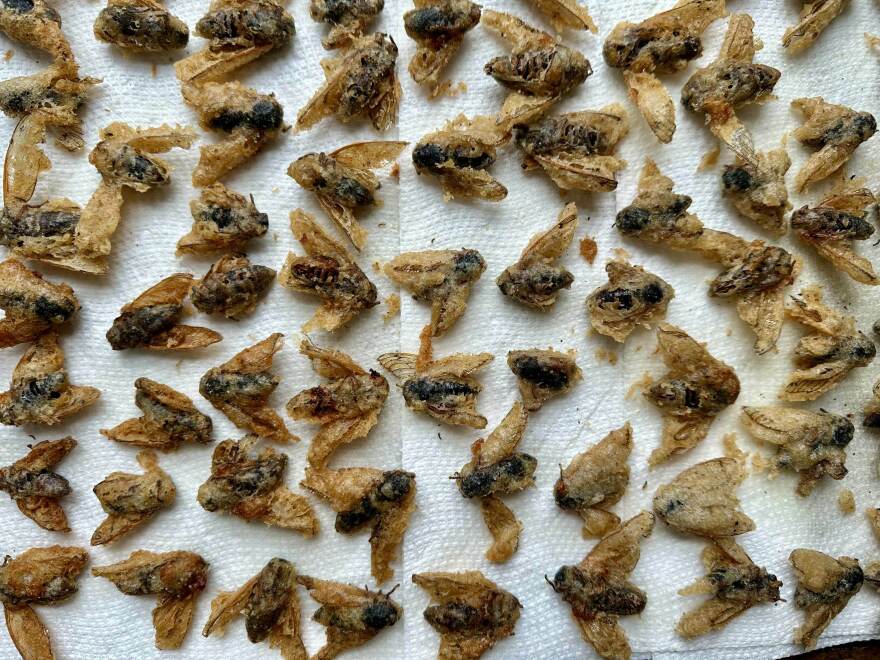The cicadas are coming! And so are some new flavor profiles.
This spring, the bugs of two broods, the 13-year Brood XIX and the 17-year Brood XIII, will crawl from the ground simultaneously across the eastern and southern parts of the United States. It is the first time the two broods will emerge in unison since Thomas Jefferson was president.
But for chef Joseph Yoon, it won't be the first time cicadas are on the menu. "It originally started when I cooked some insects for an art project," says Yoon.

Yoon is an advocate for the UN's International Fund for Agricultural Development. He is also a founder of Brooklyn Bugs, a group of edible insect ambassadors who are passionate about bug consumption, education, and climate consciousness.
With the arrival of trillions of cicadas this year, Yoon is preparing to cook up some tasty recipes, like tempura-fried cicadas and cicada kimchi. With the right ingredients and preparation, he says, the taste isn't too unfamiliar.

"If you think about it, they've been living underground, slowly feasting on plant and tree xylem for 13 or 17 years. And so they have this really beautiful vegetal quality and a nutty quality as well. And so when you deep fry them, they're just so delicious and so special," says Yoon.
Planet-friendly food solutions
Yoon is especially interested in how edible insects can be reimagined as a primary food source. And he ponders, "How are we going to sustainably feed the world's population in 2050?"
This type of thinking could be particularly relevant in places that struggle with food insecurity – like Sudan, Yemen, and Gaza. He says because 80% of the planet's nations already consume insects, the next step is simply boosting production.
"We're talking about the rearing and husbandry, the farming of insects on a mass scale to be able to produce and then to be able to utilize it to address food security." says Yoon.
Yoon says edible insects – like cicadas – are an abundant, viable resource.
"It takes far less resources by way of the amount of water, the feed, the land. And it creates far less greenhouse gas emissions than the counterpart livestock that we're traditionally using today."
A sustainable solution, but perhaps – for some – a less than appetizing one.
Edible insect persuasion
Yoon challenges perceptions by finding new ways to integrate insects into everyday meals. For example, he suggests adding cricket powder to a classic lasagna to develop more flavor. Whether the insects are visible or disguised in the food he serves, Yoon says most people are pleasantly surprised by the taste.
"They don't know what an insect tastes like. And so they're expecting to be somehow disgusted. And that realization – it's like a light bulb moment where they're like, 'Oh, my gosh. This tastes like food and it tastes delicious,'" says Yoon.
If you're interested in trying out some edible insect meals in your own kitchen, Yoon recommends foraging in an environment that is pesticide- and chemical-free and washing and freezing cicadas before using them in any recipe.
For adventurous cooks, Yoon advises going slowly to make sure you're not allergic to the shells of some varieties of arthropods, or even the insects themselves. Shellfish allergies could also put a flag on the culinary play.
"I have a very dear friend of mine who's only allergic to mealworms," Yoon says. "He'll eat all of the other insects I cook, but not the mealworms."
Trial, no terror
Eager to try out some new taste sensations? Yoon has written recipes for the website Atlas Obscura and publications like The Explorers Journal.
Nymph Caramel-Chocolate Popcorn
Ingredients
1 cup cicada nymphs
½ cup popcorn kernels
2 tablespoons olive oil
1/2 stick unsalted butter, plus extra for drizzling over popcorn
1 1/4 cup brown sugar
1/4 cup light corn syrup
2 teaspoons vanilla extract
1/4 teaspoon baking soda
1 cup peanuts
1 cup bittersweet chocolate chips (I used Valrhona Guanaja chocolate)
Salt, to taste
Instructions
1. If you've just harvested your nymphs, be sure to wash them before freezing. After you've frozen them overnight, blanch the pre-washed nymphs for 30 seconds, then set aside to dry.
2. Add the popcorn kernels and olive oil to a large saucepan over medium heat, and make sure you cover each kernel with oil. Once the kernels have fully popped, transfer to a bowl and drizzle with the melted butter and some salt.
3. In a separate pot, add the butter, brown sugar, and corn syrup. Cook over medium-low heat, stirring frequently. Turn the heat to high when the mixture is fully incorporated and let it boil to 255 degrees F (or for a few minutes), then add the vanilla and the baking soda. Be careful as it will bubble and expand from the baking soda. Stir everything together, and add the nymphs and peanuts and mix in.
4. Pour the caramel-nymph mixture over the popcorn and stir to coat everything evenly. Spread everything over a parchment-lined baking sheet, then place in a 225- to 250-degree F oven for 60 to 90 mins, or until it dries out.
5. In a double-boiler, melt the chocolate pieces over medium heat.
6. Remove the popcorn from the oven and drizzle with the chocolate. Let it cool completely, and enjoy.
Copyright 2024 NPR




